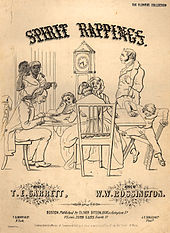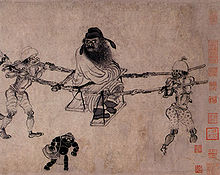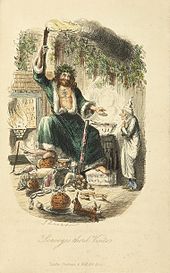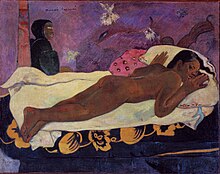Ghost

Brown Lady of Raynham Hall ghost photograph, Captain Hubert C. Provand. First published in Countrylife magazine, 1936

Engraving of the Hammersmith Ghost in Kirby's Wonderful and Scientific Museum, a magazine published in 1804
The belief in manifestations of the spirits of the dead is widespread, dating back to animism or ancestor worship in pre-literate cultures. Certain religious practices—funeral rites, exorcisms, and some practices of spiritualism and ritual magic—are specifically designed to appease the spirits of the dead. Ghosts are generally described as solitary essences that haunt particular locations, objects, or people they were associated with in life, though stories of the phantom armies, ghost trains, phantom ships, and even ghost animals have also been recounted.
Terminology
Further information: spirit, soul (spirit), anima, genius (mythology), and Geist
The English word ghost continues Old English gást, from a hypothetical Common Germanic *gaistaz. It is common to West Germanic, but lacking in North and East Germanic (the equivalent word in Gothic is ahma, Old Norse has andi m., önd f.). The pre-Germanic form was *ghoisdo-s, apparently from a root denoting "fury, anger" reflected in Old Norse geisa "to rage". The Germanic word is recorded as masculine only, but likely continues a neuter s-stem. The original meaning of the Germanic word would thus have been an animating principle of the mind, in particular capable of excitation and fury (compare óðr). In Germanic paganism, "Germanic Mercury", and the later Odin, was at the same time the conductor of the dead and the "lord of fury" leading the Wild Hunt.Besides denoting the human spirit or soul, both of the living and the deceased, the Old English word is used as a synonym of Latin spiritus also in the meaning of "breath" or "blast" from the earliest attestations (9th century). It could also denote any good or evil spirit, i.e. angels and demons; the Anglo-Saxon gospel refers to the demonic possession of Matthew 12:43 as se unclæna gast. Also from the Old English period, the word could denote the spirit of God, viz. the "Holy Ghost". The now prevailing sense of "the soul of a deceased person, spoken of as appearing in a visible form" only emerges in Middle English (14th century). The modern noun does, however, retain a wider field of application, extending on one hand to "soul", "spirit", "vital principle", "mind" or "psyche", the seat of feeling, thought and moral judgement; on the other hand used figuratively of any shadowy outline, fuzzy or unsubstantial image, in optics, photography and cinematography especially a flare, secondary image or spurious signal
Typology
Anthropological context
Further information: Animism, Ancestor worship, Origin of religion, and Anthropology of religion
A notion of the transcendent, supernatural or numinous, usually involving entities like ghosts, demons or deities, is a cultural universal. In pre-literate folk religions, these beliefs are often summarized under animism and ancestor worship.In many cultures malignant, restless ghosts are distinguished from the more benign spirits involved in ancestor worship.
Ancestor worship typically involves rites intended to prevent revenants, vengeful spirits of the dead, imagined as starving and envious of the living. Strategies for preventing revenants may either include sacrifice, i.e., giving the dead food and drink to pacify them, or magical banishment of the deceased to force them not to return. Ritual feeding of the dead is performed in traditions like the Chinese Ghost Festival or the Western All Souls' Day. Magical banishment of the dead is present in many of the world's burial customs. The bodies found in many tumuli (kurgan) had been ritually bound before burial, and the custom of binding the dead persists, for example, in rural Anatolia.
Nineteenth-century anthropologist James Frazer stated in his classic work, The Golden Bough, that souls were seen as the creature within that animated the body.
Ghosts and the afterlife
Further information: Soul (spirit), Psyche (psychology), Underworld, Hungry ghost, and Psychopomp
Further information: Ghost Festival, All Souls' Day, Day of the Dead, and Ghost Dance
Although the human soul was sometimes symbolically or literally
depicted in ancient cultures as a bird or other animal, it appears to
have been widely held that the soul was an exact reproduction of the
body in every feature, even down to clothing the person wore. This is
depicted in artwork from various ancient cultures, including such works
as the Egyptian Book of the Dead, which shows deceased people in the afterlife appearing much as they did before death, including the style of dress.Fear of ghosts
Main article: Fear of ghosts
While deceased ancestors are universally regarded as venerable, and often imagined as having a continued presence in some sort of afterlife,
the spirit of a deceased person which remains present in the material
world (viz. a ghost) is regarded as an unnatural or undesirable state of
affairs and the idea of ghosts or revenants is associated with a reaction of fear. This is universally the case in pre-modern folk cultures, but fear of ghost also remains an integral aspect of the modern ghost story, Gothic horror and other horror fiction dealing with the supernatural.Common attributes
Another widespread belief concerning ghosts is that they are composed of a misty, airy, or subtle material. Anthropologists link this idea to early beliefs that ghosts were the person within the person (the person's spirit), most noticeable in ancient cultures as a person's breath, which upon exhaling in colder climates appears visibly as a white mist. This belief may have also fostered the metaphorical meaning of "breath" in certain languages, such as the Latin spiritus and the Greek pneuma, which by analogy became extended to mean the soul. In the Bible, God is depicted as animating Adam with a breath.History
Ancient Near East and Egypt
Main article: Ghosts in Mesopotamian religions
Main article: Ghosts in ancient Egyptian culture
There are many references to ghosts in Mesopotamian religions - the religions of Sumer, Babylon, Assyria and other early states in Mesopotamia. Traces of these beliefs survive in the later Abrahamic religions that came to dominate the region.
Ghosts were thought to be created at time of death, taking on the
memory and personality of the dead person. They traveled to the
netherworld, where they were assigned a position, and led an existence
similar in some ways to that of the living. Relatives of the dead were
expected to make offerings of food and drink to the dead to ease their
conditions. If they did not, the ghosts could inflict misfortune and
illness on the living. Traditional healing practices ascribed a variety
of illnesses to the action of ghosts, while others were caused by gods
or demons.The Hebrew Bible contains few references to ghosts, associating spiritism with forbidden occult activities cf. Deuteronomy 18:11. The most notable reference is in the First Book of Samuel (I Samuel 28:3-19 KJV), in which a disguised King Saul has the Witch of Endor summon the spirit/ghost of Samuel.
There was widespread belief in ghosts in ancient Egyptian culture in the sense of the continued existence of the soul and spirit after death, with the ability to assist or harm the living, and the possibility of a second death. Over a period of more than 2,500 years, Egyptian beliefs about the nature of the afterlife evolved constantly. Many of these beliefs were recorded in inscriptions, papyrus scrolls and tomb paintings. The Egyptian Book of the Dead compiles some of the beliefs from different periods of ancient Egyptian history. In modern times, the fanciful concept of a mummy coming back to life and wreaking vengeance when disturbed has spawned a whole genre of horror stories and films.
Classical Antiquity
Further information: Shade (mythology) and Magic in the Greco-Roman world
Archaic and Classical Greece
Ghosts appeared in Homer's Odyssey and Iliad, in which they were described as vanishing "as a vapor, gibbering and whining into the earth". Homer’s ghosts had little interaction with the world of the living. Periodically they were called upon to provide advice or prophecy, but they do not appear to be particularly feared. Ghosts in the classical world often appeared in the form of vapor or smoke, but at other times they were described as being substantial, appearing as they had been at the time of death, complete with the wounds that killed them.By the 5th century BC, classical Greek ghosts had become haunting, frightening creatures who could work to either good or evil purposes. The spirit of the dead was believed to hover near the resting place of the corpse, and cemeteries were places the living avoided. The dead were to be ritually mourned through public ceremony, sacrifice and libations, or they might return to haunt their families. The ancient Greeks held annual feasts to honor and placate the spirits of the dead, to which the family ghosts were invited, and after which they were “firmly invited to leave until the same time next year”.
The 5th century BC play Oresteia contains one of the first ghosts to appear in a work of fiction.
Roman Empire and Late Antiquity
The ancient Romans believed a ghost could be used to exact revenge on an enemy by scratching a curse on a piece of lead or pottery and placing it into a grave.Plutarch, in the 1st century AD, described the haunting of the baths at Chaeronea by the ghost of a murdered man. The ghost’s loud and frightful groans caused the people of the town to seal up the doors of the building. Another celebrated account of a haunted house from the ancient classical world is given by Pliny the Younger (c. 50 AD). Pliny describes the haunting of a house in Athens by a ghost bound in chains. The hauntings ceased when the ghost's shackled skeleton was unearthed, and given a proper reburial. The writers Plautus and Lucian also wrote stories about haunted houses.
Middle Ages
Ghosts reported in medieval Europe tended to fall into two categories: the souls of the dead, or demons. The souls of the dead returned for a specific purpose. Demonic ghosts were those which existed only to torment or tempt the living. The living could tell them apart by demanding their purpose in the name of Jesus Christ. The soul of a dead person would divulge their mission, while a demonic ghost would be banished at the sound of the Holy Name.Most ghosts were souls assigned to Purgatory, condemned for a specific period to atone for their transgressions in life. Their penance was generally related to their sin. For example, the ghost of a man who had been abusive to his servants was condemned to tear off and swallow bits of his own tongue; the ghost of another man, who had neglected to leave his cloak to the poor, was condemned to wear the cloak, now "heavy as a church tower". These ghosts appeared to the living to ask for prayers to end their suffering. Other dead souls returned to urge the living to confess their sins before their own deaths.
Medieval European ghosts were more substantial than ghosts described in the Victorian age, and there are accounts of ghosts being wrestled with and physically restrained until a priest could arrive to hear its confession. Some were less solid, and could move through walls. Often they were described as paler and sadder versions of the person they had been while alive, and dressed in tattered gray rags. The vast majority of reported sightings were male.
There were some reported cases of ghostly armies, fighting battles at night in the forest, or in the remains of an Iron Age hillfort, as at Wandlebury, near Cambridge, England. Living knights were sometimes challenged to single combat by phantom knights, which vanished when defeated.
From the medieval period an apparition of a ghost is recorded from 1211, at the time of the Albigensian Crusade.Gervase of Tilbury, Marshal of Arles, wrote that the image of Guilhem, a boy recently murdered in the forest, appeared in his cousin's home in Beaucaire, near Avignon. This series of "visits" lasted all of the summer. Through his cousin, who spoke for him, the boy allegedly held conversations with anyone who wished, until the local priest requested to speak to the boy directly, leading to an extended disquisition on theology. The boy narrated the trauma of death and the unhappiness of his fellow souls in Purgatory, and reported that God was most pleased with the ongoing Crusade against the Cathar heretics, launched three years earlier. The time of the Albigensian Crusade in southern France was marked by intense and prolonged warfare, this constant bloodshed and dislocation of populations being the context for these reported visits by the murdered boy.
European Renaissance to Romanticism
The Child ballad "Sweet William's Ghost" (1868) recounts the story of a ghost returning to beg a woman to free him from his promise to marry her, as he obviously cannot being dead. Her refusal would mean his damnation. This reflects a popular British belief that the dead haunted their lovers if they took up with a new love without some formal release. "The Unquiet Grave" expresses a belief even more widespread, found in various locations over Europe: ghosts can stem from the excessive grief of the living, whose mourning interferes with the dead's peaceful rest. In many folktales from around the world, the hero arranges for the burial of a dead man. Soon after, he gains a companion who aids him and, in the end, the hero's companion reveals that he is in fact the dead man. Instances of this include the Italian fairy tale "Fair Brow" and the Swedish "The Bird 'Grip'".
Modern period of western culture
Spiritualist movement

Main article: Spiritualism
Spiritualism is a monotheistic belief system or religion, postulating a belief in God, but with a distinguishing feature of belief that spirits of the dead residing in the spirit world can be contacted by "mediums", who can then provide information about the afterlife.Spiritualism developed in the United States and reached its peak growth in membership from the 1840s to the 1920s, especially in English-language countries, By 1897, it was said to have more than eight million followers in the United States and Europe, mostly drawn from the middle and upper classes, while the corresponding movement in continental Europe and Latin America is known as Spiritism.
Scientific skepticism
Joe Nickell of the Committee for Skeptical Inquiry, wrote that there was no credible scientific evidence that any location was inhabited by spirits of the dead. Limitations of human perception and ordinary physical explanations can account for ghost sightings; for example, air pressure changes in a home causing doors to slam, or lights from a passing car reflected through a window at night. Pareidolia, an innate tendency to recognize patterns in random perceptions, is what some skeptics believe causes people to believe that they have 'seen ghosts'. Reports of ghosts "seen out of the corner of the eye" may be accounted for by the sensitivity of human peripheral vision. According to Nickell, peripheral vision can easily mislead, especially late at night when the brain is tired and more likely to misinterpret sights and sounds."Some researchers, such as Michael Persinger of Laurentian University, Canada, have speculated that changes in geomagnetic fields (created, e.g., by tectonic stresses in the Earth's crust or solar activity) could stimulate the brain's temporal lobes and produce many of the experiences associated with hauntings. Sound is thought to be another cause of supposed sightings. Richard Lord and Richard Wiseman have concluded that infrasound can cause humans to experience bizarre feelings in a room, such as anxiety, extreme sorrow, a feeling of being watched, or even the chills. Carbon monoxide poisoning, which can cause changes in perception of the visual and auditory systems, was speculated upon as a possible explanation for haunted houses as early as 1921.
Alternative explanations
The psychical researcher Thomson Jay Hudson developed his own theory about ghosts, according to Hudson ghosts and other phantoms are not deceased humans or beings from a Spirit world, instead they are memories or thoughtforms from the mind of the subject materialising or "projecting" themselves externally, Hudson also explained that where more than one person had visualised the same ghost then it can be explained by telepathic communication. The paranormal writer Paul Roland in his book The Complete Book of Ghosts (2007) argues that ghosts are the "manifestation of people still living, proving that out-of-body experiences are not as rare or as impossible as some people might think".According to (Willin, 2005) Peter Underwood favours the "electronic impulse wave theory" which claims brain waves become more active in higher stress rates and that at a certain level will produce a ghost which is a "telepathic image that is capable of being picked up by someone else" and will fade away when people are not experiencing it. The parapsychologist George N. M. Tyrrell argued that apparitions and ghosts were telepathic hallucinations which emanate from the subconscious mind.
Paul Devereux claims that many ghost sightings can be explained by "earthlights", clouds of plasma being charged by strong electromagnetic fields occurring in areas of seismic activity, he claims that that such natural phenenoma "can respond to witness movement and thought". He explores these ideas in his book Haunted Land (2003).
By religion
Judæo-Christian
The Hebrew Torah and the Bible contain few references to ghosts, associating spiritism with forbidden occult activities cf. Deuteronomy 18:11. The most notable reference is in the First Book of Samuel (I Samuel 28:3-19 KJV), in which a disguised King Saul has the Witch of Endor summon the spirit/ghost of Samuel.In the New Testament, Jesus has to persuade the Disciples that He is not a ghost following the resurrection, Luke 24:37-39 (note that some versions of the Bible, such as the KJV and NKJV, use the term "spirit"). In a similar vein, Jesus' followers at first believe Him to be a ghost (spirit) when they see him walking on water
As such, much of the Christian Church considers ghosts as beings who while tied to earth, no longer live on the material plain. Furthermore, some Christian denominations teach that ghosts are beings who linger in an interim state before continuing their journey to heaven. On occasion, God would allow the souls in this state to return to earth to warn the living of the need for repentance.Nevertheless, Jews and Christians are taught that it is sinful to attempt to conjure or control spirits in accordance with Deuteronomy XVIII: 9–12.
Accepting, but moving beyond this position, some ghosts are actually said to be demons in disguise, who the Church teaches, in accordance with I Timothy 4:1, that they "come to deceive people and draw them away from God and into bondage." As a result, attempts to contact the dead may lead to unwanted contact with a demon or an unclean spirit, as was said to occur in the case of Robbie Mannheim, a fourteen year old Maryland youth.
Islam
The Koran discusses spirits known as jinn. Certain groups of ghosts are claimed to be capable of harming people. Therefore, Muslims defend themselves against ghosts through amulets, knives, and needles, which are considered reliable means of protection against evil. However, in cases in which the ghosts had already caused harm, Muslims may seek clergy who are purported to have the power over ghosts.By culture
European folklore
Further information: Revenant (folklore), Necromancy, and Samhain
Belief in ghosts in European folklore is characterized by the recurring fear of "returning" or revenant deceased who may harm the living. This includes the Scandinavian gjenganger, the Romanian strigoi, the Serbian vampir, the Greek vrykolakas, etc. British folklore is particularly notable for its numerous haunted locations.Belief in the soul and an afterlife remained near universal until the emergence of atheism in the 18th century. In the 19th century, spiritism resurrected "belief in ghosts" as the object of systematic inquiry, and popular opinion in Western culture remains divided.
South and Southeast Asia
India
Main article: Bhoot (ghost)
A bhoot or bhut (भूत, ભૂત, or بهوت) is a supernatural
creature, usually the ghost of a deceased person, in the popular
culture, literature and some ancient texts of the Indian subcontinent. Interpretations of how bhoots
come into existence vary by region and community, but they are usually
considered to be perturbed and restless due to some factor that prevents
them from moving on (to transmigration, non-being, nirvana,
or heaven or hell, depending on tradition). This could be a violent
death, unsettled matters in their lives, or simply the failure of their
survivors to perform proper funerals.In Central and Northern India, Shaman spirit guides play a central role.[citation needed]. It duly happens when in the night someone sleeps and decorates something on the wall and they say that if one sees the spirit the next thing in the morning he will become a spirit to and that to a skondho kata which means a spirit without a head and the soul of the body will remain the dark with the dark lord from the spirits who reside in the body of every human in Central and Northern India. It is also believed that if someone calls you from behind never turn back and see because the spirit may catch the human to make it a spirit. Other types of spirits in Hindu Mythology include Baital, an evil spirit who haunts cemeteries and takes demonic possession of corpses, and Pishacha, a type of flesh-eating demon.
Austronesia
There are many Malay ghost myths, remnants of old animist beliefs that have been shaped by later Hindu, Buddhist and Muslim influences in the modern states of Indonesia, Malaysia and Brunei. Some ghost concepts such as the female vampires Pontianak and Penanggalan are shared throughout the region. Ghosts are a popular theme in modern Malaysian and Indonesian films. There are also many references to Ghosts in Filipino culture, ranging from ancient legendary creatures such as the Manananggal and Tiyanak to more modern urban legends and horror films. The beliefs, legends and stories are as diverse as the people of the Philippines.There was widespread belief in ghosts in Polynesian culture, some of which persists today. After death, a person's ghost normally traveled to the sky world or the underworld, but some could stay on earth. In many Polynesian legends, ghosts were often actively involved in the affairs of the living. Ghosts might also cause sickness or even invade the body of ordinary people, to be driven out through strong medicines.
East and Central Asia
China

The ghosts take many forms, depending on how the person died, and are often harmful. Many Chinese ghost beliefs have been accepted by neighboring cultures, notably Japan and south-east Asia. Ghost beliefs are closely associated with traditional Chinese religion based on ancestor worship, many of which were incorporated in Taoism. Later beliefs were influenced by Buddhism, and in turn influenced and created uniquely Chinese Buddhist beliefs.
Many Chinese today believe it possible to contact the spirits of their ancestors through a medium, and that ancestors can help descendants if properly respected and rewarded. The annual ghost festival is celebrated by Chinese around the world. On this day, ghosts and spirits, including those of the deceased ancestors, come out from the lower realm. Ghosts are described in classical Chinese texts as well as modern literature and films.
A recent article in the China Post stated that nearly eighty seven percent of Chinese office workers believe in ghosts, and some fifty two percent of workers will wear hand art, necklaces, crosses, or even place a crystal ball on their desks to keep ghosts at bay, according to the poll.
Japan

Main articles: Yūrei, Onryō, and Japanese ghost story
Yūrei (幽霊) are figures in Japanese folklore, analogous to Western legends of ghosts. The name consists of two kanji, 幽 (yū), meaning "faint" or "dim" and 霊 (rei),
meaning "soul" or "spirit". Alternative names include 亡霊 (Bōrei)
meaning ruined or departed spirit, 死霊 (Shiryō) meaning dead spirit, or
the more encompassing 妖怪 (Yōkai) or お化け (Obake).Like their Chinese and Western counterparts, they are thought to be spirits kept from a peaceful afterlife.
Tibet
Main article: Ghosts in Tibetan culture
There is widespread belief in ghosts in Tibetan culture. Ghosts are explicitly recognized in the Tibetan Buddhist religion as they were in Indian Buddhism,
occupying a distinct but overlapping world to the human one, and
feature in many traditional legends. When a human dies, after a period
of uncertainty they may enter the ghost world. A hungry ghost (Tibetan: yidag, yi-dvags; Sanskrit: preta,
प्रेत) has a tiny throat and huge stomach, and so can never be
satisfied. Ghosts may be killed with a ritual dagger or caught in a
spirit trap and burnt, thus releasing them to be reborn. Ghosts may also
be exorcised, and an annual festival is held throughout Tibet for this
purpose. Some say that Dorje Shugden, the ghost of a powerful 17th-century monk, is a deity, but the Dalai Lama asserts that he is an evil spirit, which has caused a split in the Tibetan exile community.Americas
Mexico

Main article: Ghosts in Mexican culture
There is extensive and varied belief in ghosts in Mexican culture. The modern state of Mexico before the Spanish conquest was inhabited by diverse peoples such as the Maya and Aztec, and their beliefs have survived and evolved, combined with the beliefs of the Spanish colonists. The Day of the Dead incorporates pre-Columbian beliefs with Christian elements. Mexican literature and films include many stories of ghosts interacting with the living.United States
Further information: Ghosts of the American Civil War and Shadow people
According to the Gallup Poll News Service, belief in haunted houses,
ghosts, communication with the dead, and witches had an especially steep
increase over the 1990s. A 2005 Gallup poll found that about 32 percent of Americans believe in ghosts.Depiction in the arts
Ghosts are prominent in the popular cultures of various nations. The ghost story is ubiquitous across all cultures from oral folktales to works of literature.Renaissance to Romanticism (1500 to 1840)


...at the historical point at which ghosts themselves become increasingly implausible, at least to an educated elite, to believe in them at all it seems to be necessary to assert their immateriality, their invisibility. ... The drapery of ghosts must now, indeed, be as spiritual as the ghosts themselves. This is a striking departure both from the ghosts of the Renaissance stage and from the Greek and Roman theatrical ghosts upon which that stage drew. The most prominent feature of Renaissance ghosts is precisely their gross materiality. They appear to us conspicuously clothed.
Victorian/Edwardian (1840 to 1920)

Famous literary apparitions from this period are the ghosts of A Christmas Carol, in which Ebenezer Scrooge is helped to see the error of his ways by the ghost of his former colleague Jacob Marley, and the ghosts of Christmas Past, Christmas Present and Christmas Yet to Come.
Modern Era (1920 to 1970)
Professional parapsychologists and “ghosts hunters”, such as Harry Price, active in the 1920s and 1930s, and Peter Underwood, active in the 1940s and 1950s, published accounts of their experiences with ostensibly true ghost stories such as Price's The Most Haunted House in England, and Underwood's Ghosts of Borley (both recounting experiences at Borley Rectory).Children’s benevolent ghost stories became popular, such as Casper the Friendly Ghost, created in the 1930s and appearing in comics, animated cartoons, and eventually a 1995 feature film.
Noël Coward's play Blithe Spirit, later made into a film, places a more humorous slant on the phenomenon of haunting of individuals and specific locations.
With the advent of motion pictures and television, screen depictions of ghosts became common, and spanned a variety of genres; the works of Shakespeare, Dickens and Wilde have all been made into cinematic versions. Novel-length tales have been difficult to adapt to cinema, although that of The Haunting of Hill House to The Haunting in 1963 is an exception.
Sentimental depictions during this period were more popular in cinema than horror, and include the 1947 film The Ghost and Mrs. Muir, which was later adapted to television with a successful 1968-70 TV series.Genuine psychological horror films from this period include 1944's The Uninvited, and 1945's Dead of Night.
Post-modern (1970-present)
The 1970s saw screen depictions of ghosts diverge into distinct genres of the romantic and horror. A common theme in the romantic genre from this period is the ghost as a benign guide or messenger, often with unfinished business, such as 1989's Field of Dreams, the 1990 film Ghost, and the 1993 comedy Heart and Souls. In the horror genre, 1980's The Fog, and the A Nightmare on Elm Street series of films from the 1980s and 1990s are notable examples of the trend for the merging of ghost stories with scenes of physical violence.Popularised in such films as the 1984 comedy Ghostbusters, ghost hunting became a hobby for many who formed ghost hunting societies to explore reportedly haunted places. The ghost hunting theme has been featured in reality television series, such as Ghost Adventures, Ghost Hunters, Ghost Hunters International, Ghost Lab, Most Haunted and A Haunting. It is also represented in children's television by such programs as The Ghost Hunter and Ghost Trackers. Ghost hunting also gave rise to multiple guidebooks to haunted locations, and ghost hunting "how-to" manuals.








0 comments:
Posting Komentar